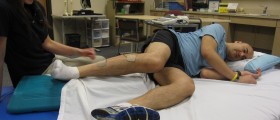
Nerve block, medically known as regional nerve blockade is the term that refers to injection of a local anesthetic near the nerve which is a source of persistent and uncontrollable pain. The procedure per se is also very reliable when used to identify specific pain generators. The effects obtained by nerve block are transient when injections need to be repeated or permanent, when the nerve blamed for painful sensation gets completely damaged by the injected substance.
Why is Nerve Block Done?
So, the basic purpose of nerve block is pain treatment and management. The procedure has different types and each of them has a specific purpose.
Therapeutic nerve blocks, for example, are indicated in painful conditions. The injection contains a local anesthetic which after being administered numbs the area innervated by the nerve and practically completely eliminates the pain.
Furthermore, there are diagnostic nerve blocks. Their goal is to determine and confirm the source of pain. The injections, in this case, contain local anesthetic with a known length of efficacy.
Additionally, prognostic nerve blocks are used to predict the result of the administered treatment.
And finally, there are preemptive nerve blocks. Their role is to avert the pain that results from some procedure.
All in all, doctors usually first opt for medications, then choose nerve block while surgery is always left as last resort when all of the conventional treatments fail to provide with sufficient pain relief.
Classification of nerve blocks can go even further when types actually refer to either the sites of injection or the very nerve/nerve plexus blamed for excruciating pain. According to the mentioned there are trigeminal nerve blocks, ophthalmic nerve blocks, supraorbital nerve blocks, maxillary nerve blocks and sphenopalatine nerve blocks. Additional types include cervical epidural, thoracic epidural and lumbar epidural block, cervical plexus and paravertebral block and brachial plexus block as well as subarachnoid and celiac plexus block. Local anesthetics are also administered in the elbow and wrist joint.
In the end, there are several more types of nerve block worth of mentioning. Sympathetic nerve block determines potential damage to the sympathetic nerve chain, the part of the central nervous system in charge of the involuntary functions. Secondly, there is stellate ganglion block, the type that evaluates potential damage to the sympathetic nerve chain supplying the head, neck, chest and arms and associated pain. And finally, one more type is facet joint block. The procedure is done to determine whether the facet joint is the actual source of pain.
The Very Procedure
There is no specific preparation for nerve block. The only thing patients might be asked is to wear a gown instead of staying in their own clothes. Also, they are advised to use the restroom before the procedure begins.
Patients are placed in the specific position on a fluoroscopic or CT table. Most commonly they lie on their stomach or the side. The position of the treated individuals is of major importance for the exact site of injection. Patients should not worry because the injection does not last long and will help them overcome the pain they have been facing for some time. Nurses are there to help treated individuals relax and remain calm throughout the procedure.
As for the equipment, the injection used for nerve block is practically the same as the one used for vaccination. The syringe is filled from a small vial of medication containing specific local anesthetic. The type of the anesthetic basically depends on the patient's needs and the type of pain he/she is experiencing.
Prior to injection, patients are subjected to fluoroscopy or CT scan. This way the doctor can determine basic anatomical parts which will serve for further guidance and allow him/her to determine the exact site where the injection should be given.
Are there any Risks to It?
The procedure is not risk-free. Similarly to other kinds of injection even nerve block has certain side effects which should be evaluated prior to the procedure. These are classified into a few groups. For instance, the side effects may be related to the very procedure, be associated with a needle puncture or result from administered medications.
The best results are achieved if the drug is administered at the desirable and precise spot. In such cases most side effects do not occur.
As far as complications go, the most common ones include infection at the injection site, allergic reactions (to administered drugs) and an increase in pain. Moreover, patients may experience elevated blood sugar level, develop skin rash and accompanying itching. Bleeding and soreness at the site of the injection may occur as well.
In rare instances and usually depending on the site of the injection i.e. the type of nerve block there is a possibility of lethal outcome.
To sum up, nerve block is highly efficient treatment against pain that does not respond well to conventional means and which simply cannot be brought under control with high doses of certain drugs. The procedure provides with temporary or permanent pain relief. In spite of some adverse effects nerve block is in general considered save procedure and is, therefore, frequently recommended.

















Your thoughts on this
Loading...